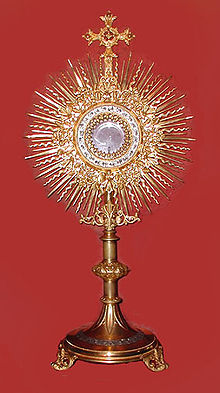The Feast of Corpus Christi, also known as the Solemnity of the Most Holy Body and Blood of Christ and the Day of Thanksgiving for the Institution of Holy Communion by the Church of England, is a Christian liturgical solemnity celebrating the Real Presence of the Body and Blood, Soul and Divinity of Jesus Christ in the elements of the Eucharist; it is observed by the Roman Catholic Church, in addition to certain Western Orthodox, Lutheran, and Anglican churches. The feast is celebrated in late May or early June, on the first Thursday after Trinity Sunday, approximately 60 days after Easter. This year, it takes place today, June 16.
 |
| Collage Floral Carpets: Asturias, Italy Poland |
Early Eucharistic festivals were glamorous affairs involving entire towns and cities. Sovereigns and nobles in European Catholic monarchies participated in the celebrations, accompanied by court officials and military officers. Commoners knelt outside their homes as these grand processions walked by. For example, every year at Corpus Christi, parishioners from Spycimierz in Poland lay a two-kilometer-long colorful carpet of living flowers. Two decorated gates are erected on this day. The villagers are as busy as worker ants, creating something on the road, analogous to what goes on in Pasadena, California before the Rose Parade. The villagers arrange colorful flowers in various elaborate patterns in a path that seems like it stretches on forever down the street. They are creating a floral pathway for the Corpus Christi procession that will take place after Mass, when Our Lord in the monstrance will be carried throughout the town, in joy and festivity. A monstrance, also known as an ostensorium, is a vessel used in Roman Catholic, Old Catholic, High Church Lutheran and Anglican churches for the display on an altar of some object of piety, such as the consecrated Eucharistic host during Eucharistic adoration or Benediction of the Blessed
Pope John Paul II led annual parades on the feast day, moving from St. Peter’s Square in the Vatican and through the streets of Rome. The Feast of Corpus Christi remains one of the essential celebrations underscoring the fundamental tenets of Christianity and Catholicism.
Obviously, the floral carpets will be destroyed as many feet tread over them during the procession. These works and the labor they require are humble gifts for Our Lord, Who has given us a gift beyond anything we can hope to repay in the Blessed Sacrament. The beautiful carpets are a small reminder of Who is passing by that day,the same Person Who humbly dwells daily in our churches, our monstrances, in our own unworthy selves in Holy Communion.
 |
| Creative Commons: A traditional "solar" monstrance |
The Feast of Corpus Christi is one of the few feasts that lay people promoted in the past. It started in the 13th century with Juliana of Liège, a canoness from modern-day Belgium who yearned for a feast day outside of Lent to honor the Eucharist. After receiving several visions of Christ, visions that began when she was 16, Juliana worked with a young monk named John of Lausanne to institute the feast day. She spent more than 40 years working towards achieving this goal. Together they composed an office by which they could celebrate the feast. They were successful, and their diocesan bishop approved the texts in 1246.
 |
| Creative Commons: Kath. Pfarrkirche St. Gordian und Epimachus, Merazhofen, Stadt Leutkirch im Allgäu, Landkreis Ravensburg Chorgestühl, 1896, Bildhauer: Peter Paul Metz Juliana von Lüttich |
Pope Urban IV declared Corpus Christi a feast day on August 11, 1264. Corpus Christi spread to nearby cities and towns, growing in popularity thanks to the efforts of Eva of Liège. Eva was an anchoress who continued Juliana’s work after her death. Ironically, Urban IV’s successors did not uphold his decree, and they suspended the festival. In 1311, Pope Clement IV reinstated the feast at the Council of Vienne.
No comments:
Post a Comment